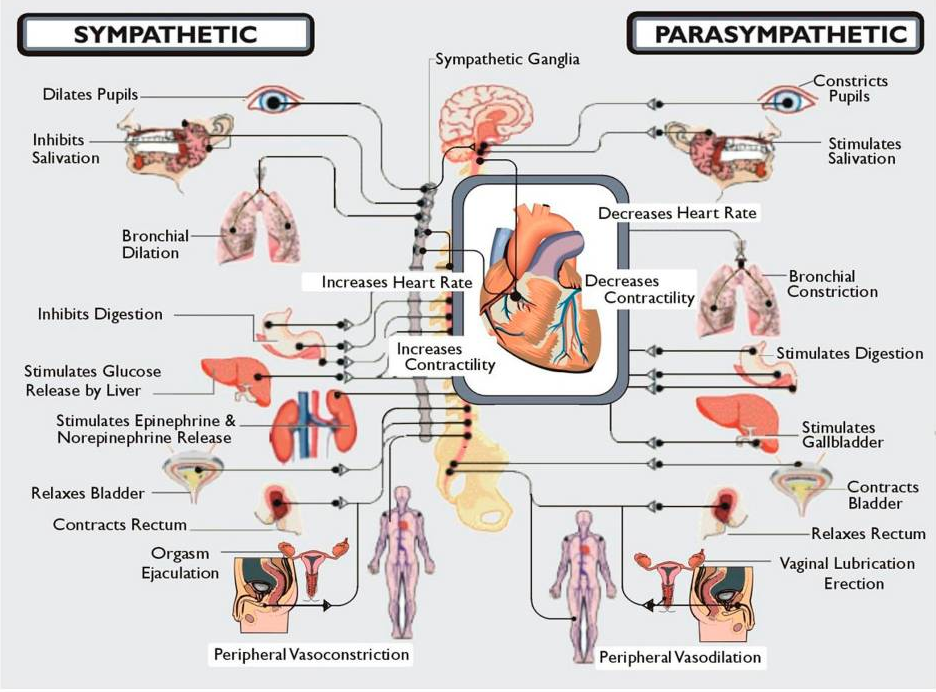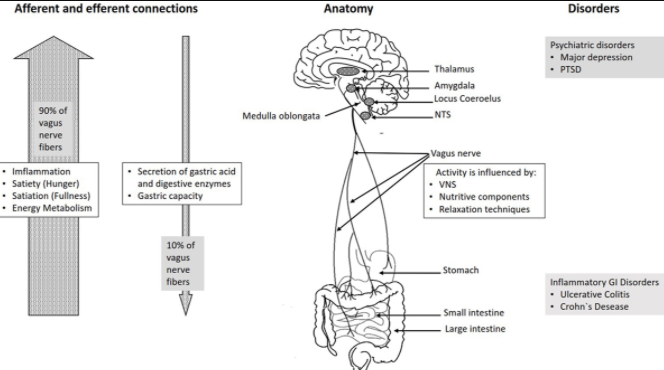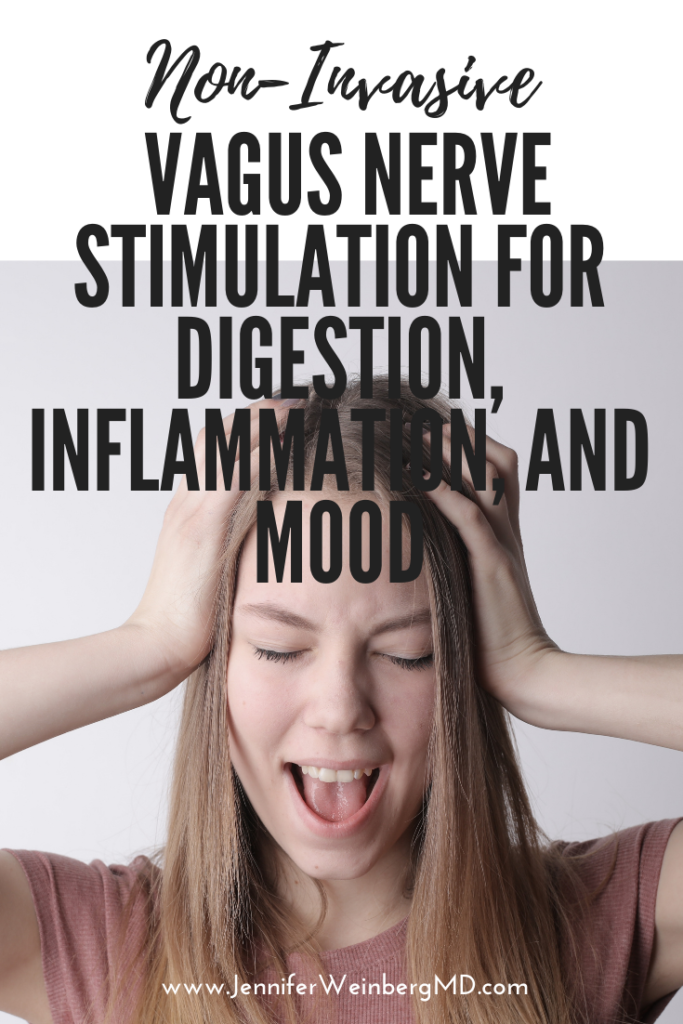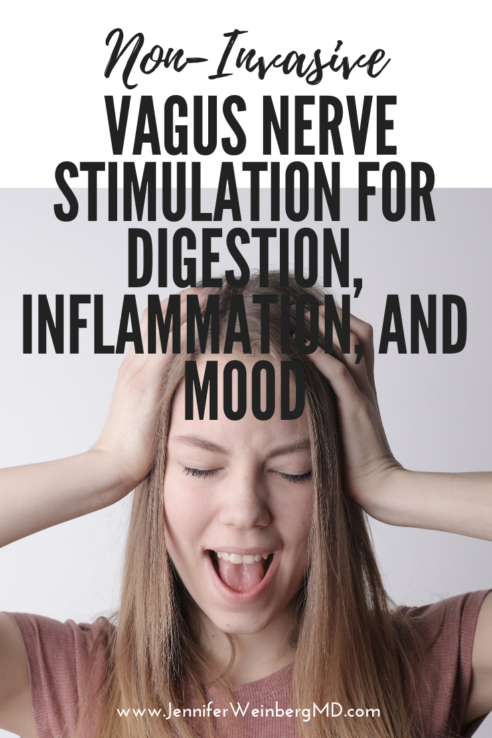Non-Invasive Vagus Nerve Stimulation for Digestion, Inflammation, and Mood
Non-Invasive Vagus Nerve Stimulation for Digestion, Inflammation, and Mood
Cranial nerve ten, the vagus nerve, plays a key role in facilitating communication between the brain and digestive tract. The tone and balance of your vagus nerve impact so many aspects of health, including inflammation, digestion, and mood. Fortunately, there are many non-invasive strategies from lifestyle medicine that you can use to stimulate your vagus nerve for greater balance.
Subscribe to my YouTube Channel for more healthy recipes, lifestyle tips and more!
Affiliate Disclosure & Privacy Policy (please review our complete policy here): we use affiliate links and analytics on our website, social media posts and newsletter which utilize cookies placed on your browser to track sales activity. This post is NOT sponsored. These statements have not been evaluated by the FDA and should not be considered medical advice or treatment. Please consult your personal health provider before making any changes to your diet or lifestyle.
The Autonomic Nervous System: Rest, Digest, and Much More
The vagus nerve (cranial nerve ten) is the main nerve of the parasympathetic (rest and digest) division of the autonomic nervous system. The autonomic nervous system (ANS) receives input from parts of the central nervous system that process and integrate stimuli from the body and external environment and contribute signals and outputs that help the body maintain balance and normal homeostatic function.

Copyright (c) 2012 Vinik.
The ANS influences the entire body including blood vessels, internal organs (stomach, intestines, liver, kidneys, bladder, genitals, lungs, heart), pupils and sweat, salivary and digestive glands. This system works largely autonomously, without your conscious effort to control the “automatic” functions of the body that you do not consciously think about, such as heart rate, blood pressure, digestion, dilation and constriction of the pupils of the eyes, kidney function, and temperature control.
The Vagus Nerve
The vagus nerve is an important route of communication between the brain, cardiovascular system, gut, and immune system. This bi-directional nerve pathway travels all the way from the brain stem down through the chest and into the abdomen, branching off to multiple organs. This wide-reaching pathway gave rise to its name, vagus, which means “wandering” in Latin.

SOURCE: Figure 1. Overview of the basic anatomy and functions of the vagus nerve from Breit et al., 2018.
Signals are sent from the brain to the organs of the chest and abdomen, as well as from the gut and organs back to the central nervous system. The vagus nerve helps orchestrate this communication network by signaling the brain to produce neurotransmitters and hormones, coordinating responses, regulating stress reactions, and helping to keep inflammation in check.
For example, the vagus nerve plays a central role in coordinating the parasympathetic relaxation response, helping to slow down breathing and heart rate, promote relaxation, stimulate digestion, and bring about a sense of peace and calm. To help coordinate this relaxation response, the vagus nerve releases the neurotransmitter acetylcholine, which seems to be a major brake on inflammation in the body.
The Brain-Gut Connection
The nervous system and digestive system are closely intertwined in what is sometimes called the brain-gut axis. The walls of your digestive tract are infiltrated by a network of nerve fibers called the myenteric plexus which contributes to the enteric nervous system. This enteric nervous system is part of the autonomic nervous system which receives signals from the brain. It is sometimes called your second brain within your gut since it receives many signals from the brain and communicates signals back to the central nervous system as well.
As part of this brain-gut axis, the vagus nerve establishes one of the main connections between the brain and the gastrointestinal tract. It acts as a communication pathway that sends information about the state of the inner organs of the abdomen to the brain via afferent fibers and conveys signals from the brain and central nervous system back to the digestive tract.
You have likely experienced this brain-gut connection before when you sense a “gut feeling,” “butterflies in your stomach” or anxiety-induced nausea. Since the nervous system and digestive system are closely intertwined in this way, the digestive system is particularly vulnerable to the presence of stress, especially when it becomes chronic.
The Vagus Nerve as Modulator of the Brain–Gut Axis
Since the vagus nerve is a major control center for the body, the health of this nerve is of utmost importance to the health of your brain, immune system, and overall inflammatory state. The bidirectional communication between the brain and the gastrointestinal tract via the brain–gut axis involves the vagus nerve which also interacts with sympathetic nerves of the autonomic nervous system (e.g., via the prevertebral ganglia), the endocrine system, and the immune system. The gut microbiota also influences these communications to contribute to the regulation of the gastrointestinal tract and connect emotional and cognitive areas of the brain with gut functions.
Vagal Tone
Some people have stronger vagus nerve activity than others, allowing their bodies to relax more quickly after stress. The strength of your vagus response is known as vagal tone and contributes to your overall resilience to stressors.
Low vagal tone has been associated with chronic inflammation. Research shows that those with inflammatory conditions, such as rheumatoid arthritis and other autoimmune diseases, often have decreased heart rate variability, a marker of reduced vagal tone. This reduced vagal tone triggers the production of pro-inflammatory cytokines (substances secreted by inflammatory cells and affect other cells) and leads to an increase in sympathetic nervous system activity and stress hormones, contributing to systemic inflammation.
Vagus Nerve Stimulation for Mood and Digestion
Emerging research suggests that the vagus nerve may be an effective target in treating various psychiatric, inflammatory, and gastrointestinal disorders. Research shows that stimulating the vagus nerve acts as a natural anti-inflammatory and tranquilizer since it reduces the production of proinflammatory cytokines and calms the nervous system. Therefore vagal nerve stimulation has been studied as an adjunct treatment for treatment-refractory depression, posttraumatic stress disorder, inflammatory bowel disease, and irritable bowel syndrome.
Vagus nerve stimulation often involves applying electrical impulses to the nerve via direct invasive stimulation with a surgically implanted device or indirect transcutaneous (across the skin) non-invasive stimulation. Transcutaneous stimulation is often done by attaching a vagal nerve stimulator to the ear to act on the afferent auricular branch of the vagus nerve.
Treatments that target the vagus nerve aim to increase the vagal tone and inhibit cytokine production to support resiliency. Stimulating the afferent fibers of the vagus nerve in the gut influences serotonin, dopamine, norepinephrine, epinephrine, and/or histamine (monoaminergic) neurotransmitter systems in the central nervous system that play crucial roles in major psychiatric conditions, such as mood and anxiety disorders.
Non-Invasive Ways to Modulate Vagus Nerve Function

Given these findings, there are many ways to help improve vagal tone, balance the stress response, reduce overall chronic stress, boost resilience, and improve digestive health. These approaches are based on mindfulness, stress-management, functional nutrition, and lifestyle medicine approaches.
Be sure to consider these strategies in conjunction with your health care provider to find an approach that is appropriate for your unique needs.
The Vagus Nerve’s Interaction with the Microbiome

One way the health of the vagus nerve appears to influence these conditions is via the health of the microbiome. The microbes which inhabit our digestive tract and play many important roles in our health seem to respond directly to stress-related signals. Stress-induced disruption of the microbiome can also increase susceptibility to infections, influence weight, and impact metabolism.
A healthy balance of gut bacteria can have a beneficial effect on mood and anxiety, in part through its influence on vagus nerve activity. When your gut has a healthy balance of microbes, you have less intestinal permeability, improved resistance to illness, and better psychological and gastrointestinal health.
A healthy gut that houses a balanced microbiome is more resistant to the negative impacts of inevitable stress. There are many lifestyle and nutrition habits that can influence the composition of your gut microbiome.
- Omega-3 fatty acids and fat-soluble vitamins A and D can help to heal the intestinal lining, reduce inflammation and provide a diverse array of beneficial bacteria. This makes your digestive tract more resilient to the harmful impacts of stress.
- Prebiotics are functional foods that promote the growth and/or activity of beneficial gut bacteria. Specific types of dietary fibers are prebiotic foods that nourish healthy gut bacteria. These include inulin, fructo-oligosaccharides (FOS), galactooligosaccharides (GOS), and oligosaccharides which are non-digestible carbohydrates are found in foods like bananas, asparagus, onions, oats, garlic, and Jerusalem artichokes.
- Probiotics are live or attenuated microorganisms that can help to populate the gut microbiome when taken in appropriate amounts (Petschow et al., 2013). Including naturally fermented foods, such as raw sauerkraut and kombucha, can contribute to microbial diversity.
Self-Massage for Vagus Nerve Tone

An emerging technique for reducing inflammation and toning the vagus nerve is a type of self-abdominal massage. Moderate pressure massage has been shown to stimulate the vagus nerve, increase the movements of the digestive system and contents, and improve insulin secretion to help balance blood sugar in preterm infants (studies on adults have yet to be done). The combination of manual manipulation and stimulation of the vagus nerve can have powerful anti-inflammatory benefits.
If you would like to try this technique, this mp4 audio guided self-massage and relaxation exercise will teach you a natural, easy method for activating your vagus nerve and strengthening your vagal tone to help balance your immune system, calm the body and mind, and reduce inflammation. Stimulating the vagus nerve acts as a natural anti-inflammatory and tranquilizer since it reduces the production of proinflammatory cytokines and calms the nervous system.
- This audio recording guides you step-by-step through a relaxing self-massage technique. The combination of manual manipulation and stimulation of the vagus nerve can have powerful anti-inflammatory benefits. This abdominal massage technique is easy to do at home in just a few minutes.
- Use this exercise alone or in conjunction with the other guided meditations and breathing exercises in Breathe: Guided Relaxation & Breathing Exercises to Help You Find Your Whole Cure
Mindfulness, Yoga, and Breathing for Vagus Nerve Balance

Several mindfulness and meditation techniques have also been shown to modulate the vagus nerve with therapeutic effects. Relaxation and focused breathing exercises (like those in Breathe) increase vagal tone to provide greater autonomic balance. Deep breathing triggers the parasympathetic nervous system which activates processes involved in rest, repair, and digestion. When the body is in parasympathetic mode, blood flow, and oxygenation to the digestive tract are increased, making digestion more efficient.
Techniques like progressive muscle relaxation, visualization, and mindfulness meditation are also effective ways to shift into a more parasympathetic state which favors relaxation and healthy digestion.
- For example, self-generated positive emotions via loving-kindness meditation increase vagal tone. You can try this self-compassion meditation to open up your heart and build kindness in your life through cultivating self-compassion and giving of your authentic self. As you look within and take time for self-observation, energize your heart center and connect with your creativity, self-expression, and compassion.
- Certain yoga postures and pranayama breathing practices can directly stimulate the vagus nerve to increase vagal tone and improve autonomic regulation, mood, and cognitive function. Yoga practices that coordinate the breath with movement are especially effective at reducing the state of constant hyperarousal which is detrimental to digestion.
- The breath is a beautiful tool that is free, is always with you, requires no equipment, and can be used simply to improve your health. Regularly practicing mindful breathing can be both calming and energizing, bringing greater tone and balance to the vagus nerve. You can control your breath and use it to reduce stress and achieve a relaxed state. The breathing exercises and guided relaxation experiences presented in Breathe: Guided Relaxation & Breathing Exercises to Help You Find Your Whole Cure can be used anywhere, at any time of day. Try using them when you feel panic, stress, anxiety, or just want a few moments of calm in your day. They are also helpful for coping with pain and helping the body prepare for rest and relaxation.
When you learn to understand your emotions and responses to stress and adopt healthy ways to manage stress like those presented in The Whole Cure (affiliate link), you can build resilience and favorably modulate vagus nerve function.
Mindfulness education and practice are a big part of the Simple Pure Whole Solution! Here are a few resources that can support your mindfulness practice during times of uncertainty, anxiety, fear, and calm:
Mindfulness Resources for Self-Healing:



- Download your free chapters and wellness prescriptions now and get started incorporating a more mindful approach into your life and building resiliency. You can also get your copy of The Whole Cure in paperback or Kindle edition from Amazon.
- My Mindfulness Resources for Crisis and Self-Healing Package provides you with professionally-designed worksheets, handouts and workbooks for creating habits and practicing tools that support optimal stress management, resilience and coping with difficulty.
- Try some guided meditations and relaxation exercises from my Breathe CD.
Mindfulness Resources for Health Care Practitioners:
- If you are a health coach or other health care professional, I heard from many of you requesting done-for-you content and tools for easy-to-incorporate mindfulness practices that you could use during this time with your clients and patients. To address this need, I want to offer my Done-for-You Package of Mindfulness Resources for Crisis and Calm at 70% off the regular price. Right now you can get the complete package for only $67 here. This Done-for-You Package of Mindfulness Resources for Crisis and Calm provides professional mindfulness resources for coaching and sharing self-healing tools and practices to empower you to teach others how to disconnect from panic, fear and anxiety and build inner peace.
- My newest done-for-you workshop package Rest, Restore & Rejuvenate to Mindfully Manage Stress is the perfect way to offer support for stressful times and everyday optimal health. You can use this completely done-for-you workshop package with your clients or for a virtual teleworkshop or series of sessions. The package includes everything done for you, from a complete word-for-word script to handouts for your clients to a guided exercise to a complete instruction guide so you are ready to confidently share this guidance with people right away.
You can also join me on Instagram for mini-mindfulness moments, exercises and discussions on how to add ease and purpose into life.
Join us on Instagram for more mindfulness moments!
Medical Disclaimer: Information provided in this post and related resources are for informational purposes only. Jennifer Weinberg is not providing medical advice, diagnosis or treatment information. The information is NOT intended as a substitute for the advice provided by your physician or other healthcare professional. Every body is unique so be sure to check with your healthcare professional before making any dietary or lifestyle changes, taking any medication or nutritional supplement or using any treatment for a health issue. Do not use this information provided for diagnosing or treating a health problem or disease. If you suspect you have a medical problem please contact your healthcare provider promptly and do not disregard professional medical advice based on anything on this website. This website and related resources are not intended to diagnose, treat, cure or prevent disease and do not create a doctor-patient relationship between you and Jennifer Weinberg. These statements have not been evaluated by the FDA. These products are not intended to diagnose, treat, cure, or prevent any disease.









Comments